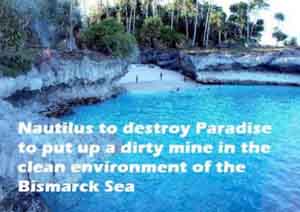
Martyn Namorong | Namorong Report
OPINION: PORT MORESBY (PNG Mine Watch / Pacific Media Watch): Dr Ila Temu, the spokesperson for mining companies in Papua New Guinea recently raised a series of points in support the Somare government’s decision to allow Nautilus Minerals to destroy the Bismarck Sea and Mining Minister Byron Chan’s decision to maintain the status quo.
Dr Temu highlighted that many organisations were misinforming the public about the issue. However, if one takes a look at maps on Nautilus Minerals' website, one will begin to appreciate the scale of the disaster Nautilus intends to create. Nautilus has tenements over vast areas of the Bismarck Sea and the internal waters of Milne Bay Province.
Dr Temu claims that since Nautilus Minerals has received government approvals, its exploits are sound. One only has to look at government-approved projects like, Panguna, Ok Tedi Mine, Pogera and Hidden Valley to appreciate the fact that government approvals cannot be trusted.
The manner by which the Somare government was willing to amend environmental laws in favour of mining companies, also indicates the standards used to give approvals.
In any case, what body of scientific knowledge about the territorial waters of PNG has the government of PNG used to create the necessary legislative, institutional, policy and regulatory frameworks necessary to approve and regulate seabed mining?
Professor Richard Steiner from the University of Alaska Marine Advisory Program reviewed Nautilus Minerals' Environmental Impact Statement. His concluding remarks stated that,“…clearly, the project is not sustainable, as it exploits a relatively finite mineral deposit, lasts only 30 months, contributes a relatively small amount of money to [Papua New Guinea], severely damages the benthic habitat for a rare deep sea sulfide mound ecosystem and poses risk to other marine resources in the region…”
It would be interesting for the Department of Environment and its former boss Wari Iamo to explain to the people of Papua New Guinea how they assessed Nautilus Minerals EIS and how they came up with monitoring mechanisms.
Risks highlighted
The recent Tumbi landslide in the Southern Highlands highlights the risks posed by large extractive industries in terms of creating man-made disasters. Nautilus Minerals will be altering seafloor morphology in an actively tectonic region.
Natural undersea tectonic events pose a number of geohazard risks (e.g Aitape Tsunami) to coastal communities. The activities Nautilus will only add to these risks.
Dr Temu also highlighted that any action by the government to stall Nautilus Minerals’ Solwara 1 project would increase Papua New Guinea’s sovereign risk profile. Commenting on the possibility of government intervention, Dr Temu said: “This would also raise concerns in the international investment community of the dangers of sovereign risk.“
Sovereign risk refers to the credit worthiness of the “sovereign”, i.e the government, and is used as a measure by financial institutions as to whether a country is worth investing in. It is measured using complex mathematics and data but in a nutshell it reflects on two main variables: political risks and fiscal risks.
Will stalling Nautilus increase PNG’s sovereign risk profile? On face value yes. But when put in context, the risk is not significant. We live in a World where compared to the sovereign risk profiles of debt-ridden European Economies, PNG is a much better destination for investment.
PNG doesn’t have to worry about any sovereign risk associated with small players like Nautilus Minerals when a major player like Exxon Mobil has shown confidence in PNG as a destination for major long term investments. The LNG project is a much longer, 30 year investment compared to Nautilus’s 30 month mining experiment.
At a recent conference in Sydney, Peter Graham, the managing director for Esso Highlands Ltd, highlighted that the LNG Project makes PNG a good investment destination. “The Project will generate many direct benefits but also contribute indirectly to growth by stimulating associated businesses and demonstrating to the world that PNG can be an attractive investment destination,” he said.
In a world where there is growing demand and depletion of natural resources, PNG is now better placed to dictate the terms by which it resources are extracted. The granting of licences and permits to Nautilus were flawed and the injustice perpetrated against coastal communities must be corrected.
There are an increasing number of MPs in the O’Neil Government that oppose Seabed Mining. Maverick Madang politician, Ken Fairweather was the first MP to oppose experimental seabed mining. Planning Minister, Charles Abel has signed the petition against Seabed Mining and his Governor, Titus Philemon has done likewise. Oro Governor Gary Juffa leads a group of middle bench MPs who also would like to see a moratorium on Seabed Mining in PNG. Madang Governor Jim Kas has also expressed his opposition to the project.
Given current local and global economic conditions, Dr Ila Temu may may be exaggerating the sovereign risk associated with stopping Nautilus. Nautilus Minerals’ 30 month Seabed Mining Experiment in insignificant compared to the greater scheme of things in PNG.
The people of PNG and their Leaders can confidently stop this evil act with very few adverse effects to the investment environment in PNG. The lesson here for foreign corporations is that gone are the days when you can take short cuts, mislead and bully the people of PNG.

This work is licensed under a Creative Commons Attribution-NonCommercial 3.0 New Zealand Licence.



